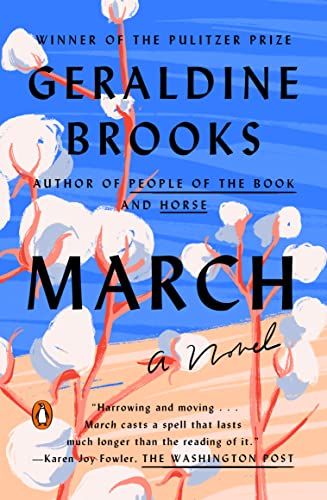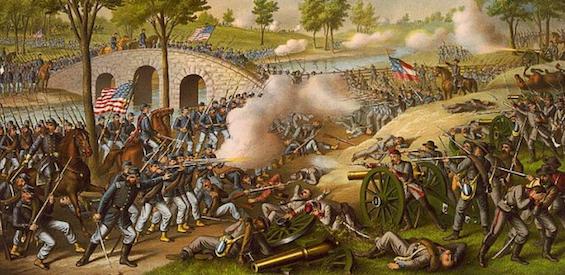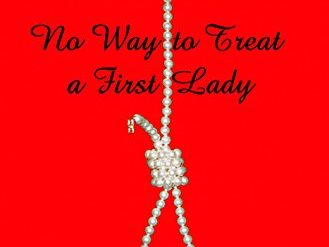
Skim the list of past Pulitzer and National Book Award-winners. You won’t find there many that appear familiar years after their publication. But March, which won the Pulitzer Prize for Fiction in 2006, seems destined to be read far into the future. Like Geraldine Brooks‘ other works of historical fiction, especially Year of Wonders and People of the Book, both international bestsellers, this Civil War novel is rooted in often-cultivated ground but grows into a story that is fresh, original, and moving. You might not imagine that anyone could write a novel in the 21st Century about the American Civil War and create anything new. But Geraldine Brooks has done it.
Estimated reading time: 5 minutes
The absent father in a 19th century bestseller
March tells the untold tale of the absent father in Louisa May Alcott’s 19th Century bestseller, Little Women. Mr. March is a passionately idealistic transcendentalist preacher in Concord, Massachusetts, a romanticized version of Alcott’s own famous father. At the advanced age of 39, he joins the Union Army as a chaplain soon after the cannons roar at Fort Sumter.
The letters Mr. March writes home to his beloved wife, Marmee, paint a picture of ease and uplift, but his true experiences in the war are gruesome and traumatic. During his time with the army, he encounters Grace, a beautiful and well-spoken liberated slave. Twenty years earlier, he had known her briefly and lusted after her when he was traveling as a peddler in the South, working to win his fortune.
The plot of the novel revolves around the intersections of his life with Grace’s, revealing truths long hidden from our history books. The unmentionable relationships between Whites and Blacks in the antebellum South. The racism that runs as deeply among Northern troops as Southern. And the sad consequences for March’s life.
March by Geraldine Brooks (2005) 320 pages ★★★★★
Winner of the Pulitzer Prize for Fiction

Facts we rarely learn about the Civil War
The American Civil War is sometimes called the first modern war, featuring accurate, long-range, rifled muskets and the first rudimentary machine guns. But it was also fought up close and personal, sometimes neighbor to neighbor and brother to brother. The country was far smaller then, with a population in 1860 of just 31 million—less than one-tenth of today’s. So it was far more likely that pre-war acquaintances might encounter one another in the course of the fighting. As is the case when Mr. March meets Grace in this novel.
Conjure up an image of the Civil War based on what you learned in school, and what do you see? Ranks of young soldiers in blue or gray—and they’re all White. But it wasn’t so. According to the National Archives, “By the end of the Civil War, roughly 179,000 black men (10% of the Union Army) served as soldiers in the U.S. Army and another 19,000 served in the Navy. Nearly 40,000 black soldiers died over the course of the war—30,000 of infection or disease.”
Black men served in large numbers for the Confederacy, too. Tens of thousands of them, in fact. “Most of these were forced to accompany their masters or were forced to toil behind the lines. Black men were not legally allowed to serve as combat soldiers in the Confederate Army—they were cooks, teamsters, and manual laborers.” Slaves, of course. And they did work that White Southerners might otherwise have had to do, thus freeing up more men for the fighting.
About the author

Geraldine Brooks is an Australian reporter who moved to the United States for a master’s in journalism. She worked for several years as a foreign correspondent for The Wall Street Journal and wrote for The New Yorker as well. But there is no trace of the journalist’s detachment in any of her fiction. She approaches all her novels from a deeply personal perspective.
For example, Year of Wonders, the fact-based tale of an isolated English village struck by the bubonic plague, grew from Brooks’ visit to the historic village. And People of the Book came about in part because of her conversion to Judaism, the religion of her late husband, Pulitzer-Prize-winning journalist and author Tony Horwitz. March reflects both Brooks’ desire the learn more about the history of her newly adopted country and her husband’s deep involvement in Civil War history.
For related reading
You’ll find all of the author’s books at The outstanding historical fiction of Geraldine Brooks.
I’ve also reviewed another excellent novel about the Civil War: The March by E. L. Doctorow (A moving novel about Sherman’s March to the Sea).
If you enjoy reading history in fictional form, check out 20 most enlightening historical novels. And if you’re looking for exciting historical novels, check out Top 10 historical mysteries and thrillers.
You might also be interested in Top 10 great popular novels or Top 20 popular books for understanding American history.
And you can always find my most popular reviews, and the most recent ones, on the Home Page.


























